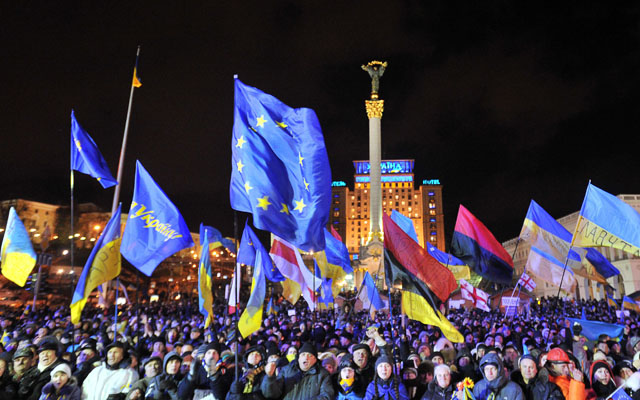GENYA SAVILOV/AFP/Getty Images/Newscom
The brutal dispersal of demonstrators in Ukraine last week led to dozens wounded—and a public protest movement which now surpasses the Orange Revolution of 2004. Demonstrators want Ukraine in Europe—and President Victor Yanukovich out of power. Ariel Cohen, Heritage’s Senior Research Fellow for Russian and Eurasian Studies, gives some perspective on where this is coming from.
What is the crisis in Ukraine all about?
The new generation, which grew up under independence, opposes Yanukovich, who derailed three years of negotiations with the European Union and refused to sign the Association Agreement with the EU at the November Eastern Partnership summit in Vilnius, Lithuania. When Yanukovich returned from Vilnius empty-handed, tens of thousands of young (and not so young) people filled the Independence Square (the Maydan), to launch EuroMaydan, an ongoing mass demonstration.
Ukraine first gained independence from the Romanov Empire in 1918, only to be occupied by the Russian Red Army in 1919; it regained independence after the collapse of the Soviet Union in 1991. Ukraine was always torn between Russia and the West.
Why should Americans care?
First, there are 2.5 million Americans and Canadians of Ukrainian descent, many of whom have ties to the “old country.” Second, this is the largest country in Europe, much bigger than France, with over 40 million people, outstanding agricultural resources, massive industry (including aerospace, steel, and chemicals), and an educated population striving to live in a Europe-like state—not in a Russian-dominated authoritarian, corrupt state.
We care because Ukraine has suffered, was a captive nation under communism, and lost 5 million people from Stalin-inspired famine—and possibly another five million more in the Holocaust, the Nazi occupation, and World War II fighting.
What is the role of Russia?
Russian President Vladimir Putin wants to rebuild a sphere of “exclusive interests” directed by Moscow and based on overlapping organizations: the Customs Union, the Eurasian Economic Space, and the Common Security Treaty Organization. He is willing to sell Ukraine much-needed natural gas and continue low-tariff trade if Ukraine joins these organizations. Russia launched a massive campaign of intimidation and punished Ukraine with higher tariff and non-tariff measures this past summer to prevent it from signing the agreement with the EU.
How did the EU and the U.S. handle this situation?
Not too well. While Poland and Sweden led the way to integrate Ukraine, key states such as Germany, Great Britain, and France were aloof. Some EU officials are afraid to expand the union after years of economic mismanagement, overwhelming bureaucracy, and slow growth, which led to high unemployment. Others are afraid of Russia’s reaction. The Obama Administration was passive on the Ukrainian Euro-Atlantic integration issue, anxious not to annoy Putin. It set the plank low: non-membership in either EU or the Customs Union.
What should the U.S. and Europe do?
We should stand shoulder to shoulder with all pro-democracy forces in Ukraine and coordinate our policies with our European allies. Ukraine should not be forced into the Russian sphere of influence against its will.
Ukraine has suffered enough—we should help her to find a home in the Euro-Atlantic space.










